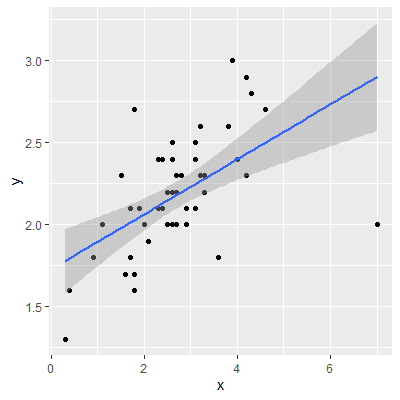Fill in Blanks
Home
1.1 Bivariate Relationships
1.2 Probabilistic Models
1.3 Estimation of the Line
1.4 Properties of the Least Squares Estimators
1.5 Estimation of the Variance
2.1 The Normal Errors Model
2.2 Inferences for the Slope
2.3 Inferences for the Intercept
2.4 Correlation and Coefficient of Determination
2.5 Estimating the Mean Response
2.6 Predicting the Response
3.1 Residual Diagnostics
3.2 The Linearity Assumption
3.3 Homogeneity of Variance
3.4 Checking for Outliers
3.5 Correlated Error Terms
3.6 Normality of the Residuals
4.1 More Than One Predictor Variable
4.2 Estimating the Multiple Regression Model
4.3 A Primer on Matrices
4.4 The Regression Model in Matrix Terms
4.5 Least Squares and Inferences Using Matrices
4.6 ANOVA and Adjusted Coefficient of Determination
4.7 Estimation and Prediction of the Response
5.1 Multicollinearity and Its Effects
5.2 Adding a Predictor Variable
5.3 Outliers and Influential Cases
5.4 Residual Diagnostics
5.5 Remedial Measures
3.4 Checking for Outliers
"If the statistics are boring, then you've got the wrong numbers." - Edward Tufte
When checking for outliers , we must think in terms of two dimensions since we have two variables, $X$ and $Y$.
Since we are interested in modeling the response variable $Y$ in model (2.1)
Since we are interested in modeling the response variable $Y$ in model (2.1)
\begin{align*}
Y_i=&\beta_0+\beta_1X_i+\varepsilon_i\\
\varepsilon_i\overset{iid}{\sim}& N\left(0,\sigma^2\right)\qquad\qquad\qquad\qquad(2.1)
\end{align*}
, we will mainly be concerned outliers with respect to $Y$. However, outliers with respect to $X$ may also be of concern if it affects the fitted line.
To show how outliers can effect the fitted line, 50 observations are shown in Figure 3.4.1 along with the fitted line shown in blue.
You can click on the points and move them on the plot and see the effect on the fitted line.
Try moving a point in the $X$ direction and then try moving in the $Y$ direction.
Note that if the point is moved away from the blue line closer to the ends (such at around $X=0$ or $X=6$) it has more of an effect on the fitted line than moving a point away from the line around the middle (such at around $X=3$).
Try moving a point in the $X$ direction and then try moving in the $Y$ direction.
Note that if the point is moved away from the blue line closer to the ends (such at around $X=0$ or $X=6$) it has more of an effect on the fitted line than moving a point away from the line around the middle (such at around $X=3$).
Figure 3.4.1: Outiers
Since the effect on the fitted line is determined mainly by how far the point is from the line, we will identify outliers by examining the residuals, in particular, the semistudentized residuals
\begin{align*}
e_{i}^{*} & =\frac{e_{i}-\bar{e}}{\sqrt{MSE}}\\
& =\frac{e_{i}}{\sqrt{MSE}}\qquad\qquad\qquad(3.3)
\end{align*}
We can plot $e_{i}^{*}$ against $X$ or against $\hat{Y}$. A general rule of thumb is any value of $e_{i}^{*}$ below -4 or above 4 should be considered an outlier. Note that this rule is only applicable to large $n$.
In Chapter 5, we will discuss other methods for detecting outliers.
In Chapter 5, we will discuss other methods for detecting outliers.
Let's examine 50 observations of $X$ and $Y$:
We can see from the semistudentized plot that there is one observation with a value of $e^*$ below -3. Although this is not below the rule of thumb of -4, we note that our sample size $n$ is only moderate and not large. So we may want to investigate an observation with a value of $e^*$ below -3.
Once we see there is a potential outlier, we must investigate why it is an outlier. If the observation is unusually small or large due to a data recording error, then perhaps the value can be corrected or just deleted from the dataset. If we cannot determine this is the cause of the outlier for certain, then we should not remove the observation. This observation could be unusual just due to chance.
library(tidyverse)
dat = read.table("http://www.jpstats.org/Regression/data/example_03_04_01.csv", header=T, sep=",")
ggplot(dat, aes(x=x,y=y))+
geom_point()+
geom_smooth(method = "lm")
 fit = lm(y~x, data=dat)
#calculate semistudentized residuals
dat$e.star = fit$residuals / summary(fit)$sigma
ggplot(dat, aes(x=x, y=e.star))+
geom_point()
fit = lm(y~x, data=dat)
#calculate semistudentized residuals
dat$e.star = fit$residuals / summary(fit)$sigma
ggplot(dat, aes(x=x, y=e.star))+
geom_point()

We can see from the semistudentized plot that there is one observation with a value of $e^*$ below -3. Although this is not below the rule of thumb of -4, we note that our sample size $n$ is only moderate and not large. So we may want to investigate an observation with a value of $e^*$ below -3.
Once we see there is a potential outlier, we must investigate why it is an outlier. If the observation is unusually small or large due to a data recording error, then perhaps the value can be corrected or just deleted from the dataset. If we cannot determine this is the cause of the outlier for certain, then we should not remove the observation. This observation could be unusual just due to chance.